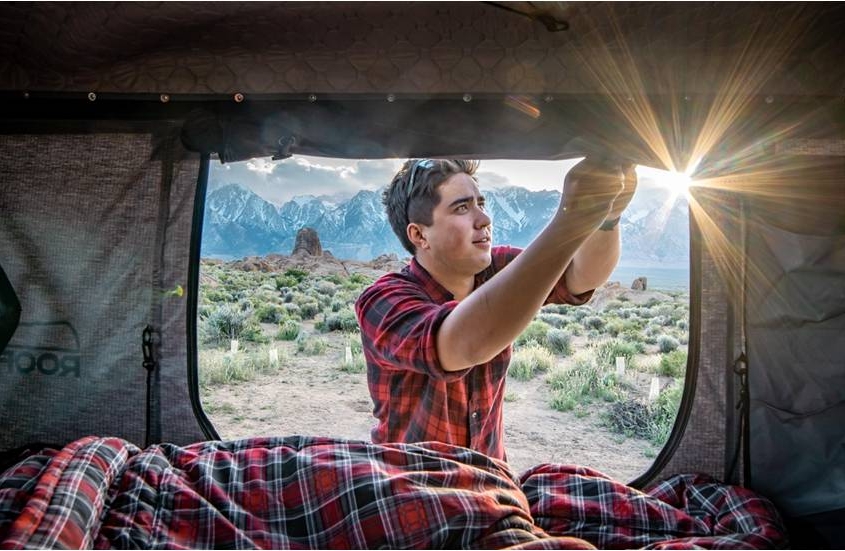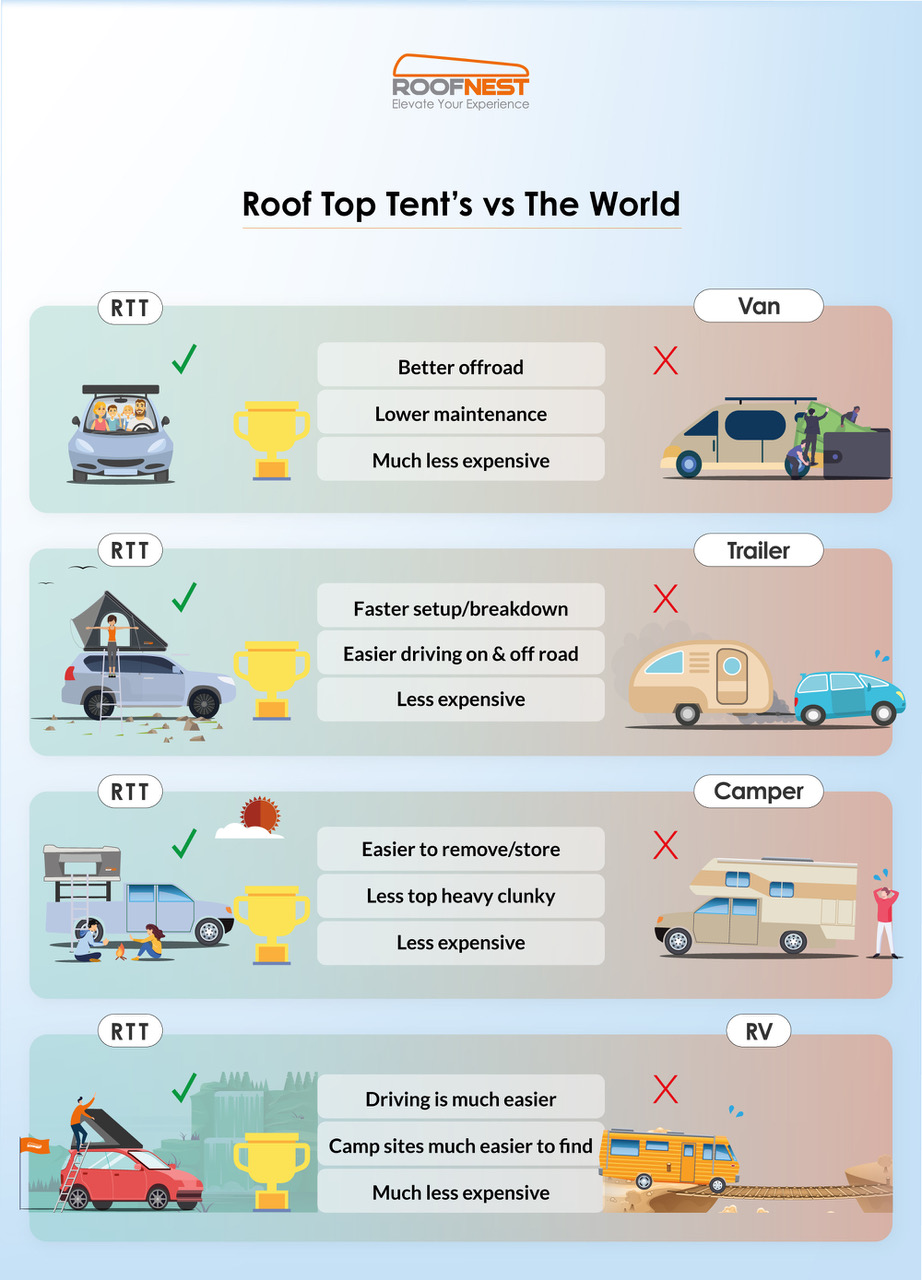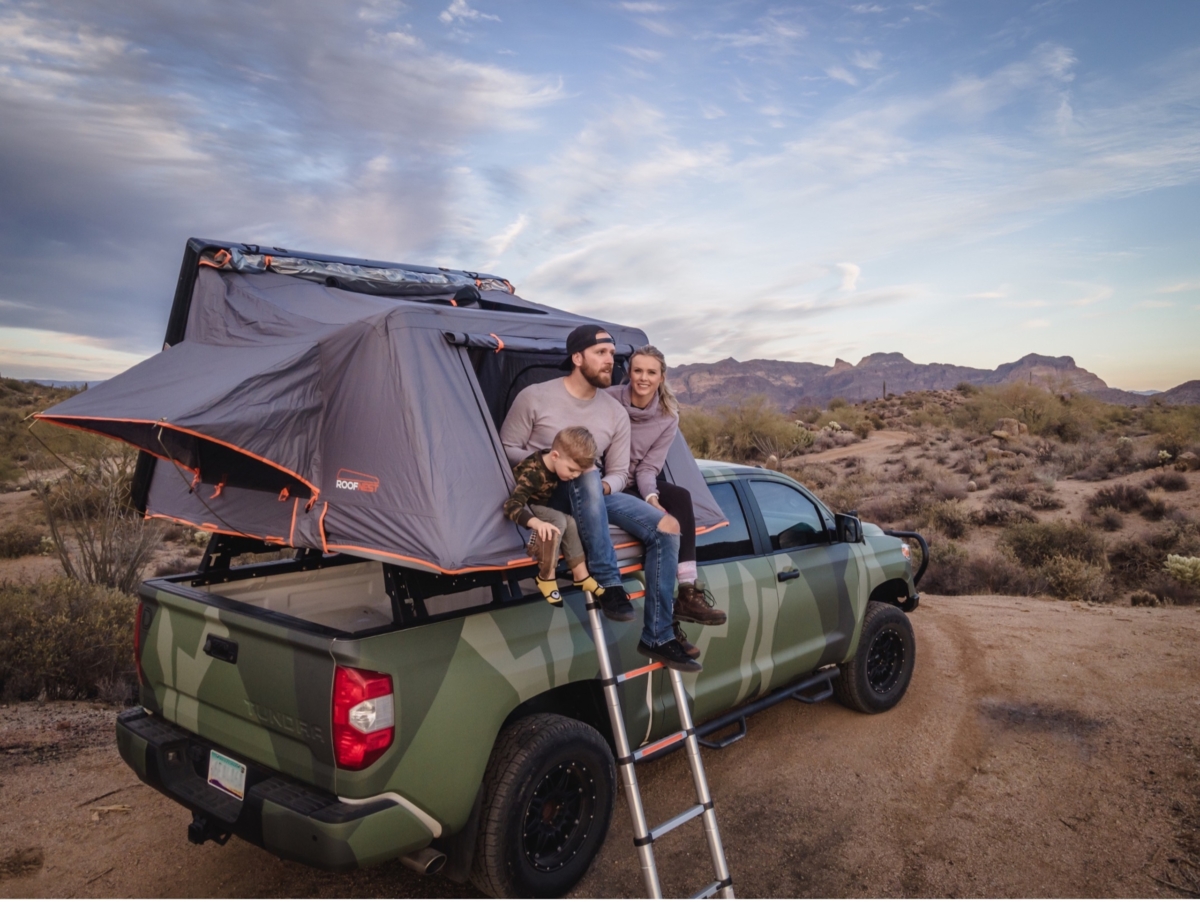in Roofnest Tips & Features / by
Whether you’re already an outdoorsy person or you aspire to be one, you’ll need a vehicle that best compliments your…well…outdoorsiness.
You need something that can safely and adequately get you into the backcountry and can keep you comfortable while you’re there.
When it comes to the best outdoor vehicle for you, there are 5 main options to choose from:
- Recreation vehicle (RV)
- Campers
- Adventure/off-road trailer
- Van
- A vehicle outfitted with a roof top tent
Each vehicle type or setup has its own pros, cons, and cost. Unless you’re an heir to a vast fortune, you’re living on a budget like the rest of us. That means the cost is likely your first consideration when compiling outdoor-adventure rigs.
And not surprisingly, the cost of different vehicles and setups have vastly different initial purchase costs, as well as ongoing costs.
But the cost isn’t the only thing that matters when choosing the right outdoor vehicle for you. Where you like to camp, how you like to camp, and how many kids/friends/pets are coming along for the journey are all important considerations, too.
To help guide you to pick the right one for you, we’ve compiled a comprehensive comparison of these distinct setups, including the cost (initial and ongoing), maintenance/setup, ease of use, versatility, and amenities/comfort.
Read on to figure out the best outdoor vehicle for your lifestyle and budget.
Recreation Vehicles
Let’s start with recreation vehicles — i.e., RVs. RVs fall into 2 categories: pull-behind trailers and motorcoaches.
While each type is pretty distinct from the other (motorcoaches contain their own powertrain), they each mostly serve the same purpose: large, luxurious homes away from home.
No matter the style, almost all RVs contain a kitchenette, bathroom, bedroom, and dining area of varying sizes and complexity.
There are even subclasses of motorcoaches and trailers, including travel trailers, fifth wheels, and Class A, B, and C. But for this article, we’ll cover them more broadly under the umbrella term “RV.”
Cost
You can purchase a fiberglass RV trailer with modest amenities and minimum floor space for around $12,000. Prices can quickly balloon upward from there into the hundreds of thousands.
Even if you can afford the initial cost (or more commonly the monthly payment — 30-year mortgage-type loans are offered for RVs), the cost of storage and upkeep need to be factored in:
- Do you have room on your property for a 30-foot RV? If not, can you afford the $15 per foot storage costs of parking it offsite?
- If something breaks, do you have room in your budget for electrical, structural, and axle components repair?
What’s more, just because you’ll be making payments on the trailer for the next 3 decades doesn’t mean it’ll last that long. More inexpensive, shoddily-built trailers begin to show wear within a couple of years.
Weight
Let’s say you opt for a 30-foot toy-hauler. It weighs 8,700 pounds. You’ll also need a vehicle that can tow more than 8,700 pounds.
In most cases, that means stepping up to a heavy-duty full-size pickup truck. Ram 2500 trucks, which can tow 10,520 pounds start at $39,990.
Do you also have room in your budget and driveway for a 21-foot, gas-thirsty truck?
Speaking of gas, don’t forget, you have to fuel your RV or the truck that tows it. Oil changes and other maintenance also need to be factored into budgetary plans.
If you’re just trying to get out and camp with your family and friends a handful of times per year, an RV might not be worth the investment.
Pros
There’s no denying that RVs are comfortable. They are the best home-away-from-home option, as they offer virtually all the amenities to which we’ve become accustomed.
Cons
Although comfortable, RVs are mostly poorly constructed. That means they won’t last long. At the same time, however, they’re incredibly expensive. And if you get pulled into a long-term loan on an RV, chances are good that you’ll be paying it off long after its useful life has been expended.
Conclusion
RVs are the best options for folks with big families, lots of friends, plenty of money to spend, and space to park an RV at home.
Campers
Like RVs, campers are old-school camping dwellings. Most slide into the bed of a full-size pickup, with a bedroom area that extends over the cab of the truck. They take the bed of your truck and turn it into a tiny house on wheels.
Campers are great solutions for folks who want to live for long periods of time out of the back of their truck. They’re also ideal for those who don’t mind parking an idle pickup truck outfitted with a camper on their property when they’re not camping.
Weight
Traditional campers can weigh upward of 1,000 pounds dry. That means they weigh 1,000 pounds before you fill the water tanks. Water weighs eight pounds per gallon. Many carry around 20 gallons of water, which is around 160 extra pounds of weight.
Most new (within the last decade) mid- and full-size pickup trucks have payload ratings above 1,500 pounds. So you won’t have to worry about overloading your rig.
That said, unless your truck is a modern heavy-duty full-size, the brakes might not be up to the challenge of handling all that additional weight. So be sure to consult your owner’s manual before buying a camper.
A cheap 1980s Ford F-150 might seem like an ideal camper platform. But be sure it can handle the weight before bolting a 1,400-pound camper to it.
Cost
Similar to RVs, campers come in all levels of luxury, from your more modest units to very plush, top-of-the-line. However, off-road-rated and ruggedized mid-range campers will run you around $13,000.
Some manufacturers will offer financing on campers. But it won’t be as easy to secure as other types of loans.
Don’t forget the cost of the truck your camper lives in. Like I mentioned above, you can try to get a cheap, older truck for your camper — but it might not be up to the challenge.
Be sure your truck’s brakes, engine, cooling system, transmission, and driveline are all up to snuff before loading a camper.
No matter whether you go with an older truck, there will be fuel, insurance, and maintenance costs to consider. Do you own the truck outright? Or are you also making payments on it?
Just because you can afford the $13,000 trailer doesn’t mean you have room in your budget for the requisite truck.
Pros
Campers are like motorcoaches but can utilize a mass-market pickup truck for the propulsion. So, if you have a trusty truck already, you can transform it into a luxury camping space relatively quickly.
And with the modern amenities of home, like heat, plumbing, LED lighting, etc., campers bring the quality of modern life into the outdoors with little to no fuss. Pack up some groceries, fire up your truck, and hit the road.
Cons
I touched on this already, but campers essentially make your pickup truck unusable on a daily basis. I mean, you can daily drive a truck with a camper. But it won’t be very easy. They’re cumbersome and decrease your fuel economy drastically. Plus, parking them isn’t easy.
Conclusion
Campers are great solutions for folks who have a trusty spare truck lying around that they can donate to camper-hauling duties, or for folks who want to spend extended periods of time in one spot in the backcountry.
Due to their size and heft, they’re not an ideal accessory for folks who are constantly on the move during their trips — overlanders, for example.
If you can afford the purchase price, the truck costs, and have driveway room to spare, there are few better and more comfortable options than a camper for living in the backcountry.
Adventure/Off-Road Trailer
On the smaller end of the scale, we have adventure or off-road trailers. They’re essentially hardy aluminum boxes on wheels.
These trailers squeeze a lot of the same features of a larger RV into a more compact, ruggedized, and utilitarian package.
Many of these kinds of trailers include a camp kitchen, water tank, awning, and — more often than not — a roof top tent.
Since these trailers are smaller, they’re easier to store. But you’ll still need to find a place to safely park them — you won’t want to leave them hooked to your vehicle indefinitely.
They’re also easier to maneuver than an RV, but safely traveling with one takes some getting used to — especially reversing, which can quickly become a brain teaser. The trick is to turn the wheel the way you want the trailer to go.
Weight
These off-road trailers can weigh as little as 500 pounds unloaded. However, you can safely assume they will tip the scales at over 2,000 pounds when fully outfitted.
But even a Subaru Outback can safely tow 2,700 to 3,500 pounds. That means there’s a good chance you won’t have to upgrade your vehicle to pull an adventure trailer.
Costs
Like RVs, the sky is virtually the limit for pricing on adventure/off-road trailers. Most can be purchased for less than $10,000 — and, depending on the manufacturer, includes the camp kitchen setup, too.
But don’t forget, you’ll need to add the cost of a roof top tent, awning, and other campsite amenities. And financial institutions don’t typically offer loans on these, so you’ll have to pay cash or get a personal loan.
In terms of additional costs, beyond the initial purchase price, off-road trailers don’t require a ton of upkeep. Brakes, tires, and bearings are all things you’ll want to keep up on, but those can last tens of thousands of miles between maintenance or replacement.
Really, filling the tanks with water and keeping your kitchen stocked with your favorite camping snacks will be your most regular cost with an adventure trailer.
Similarly, towing will add wear and tear to your vehicle, as well as decrease fuel economy. Those costs should be factored into your budgetary considerations.
And while not all states require trailer insurance, if you’re making the investment in a trailer, it’s wise to add it to your policy.
Pros
Adventure/off-road trailers pack a ton into a small, rugged package. They don’t take up too much space, but they enable you to drag along an entire camp kitchen and a small space in which to sleep.
They’re the perfect middle solution between a full-on RV and a built-out van. You can pull them with a regular vehicle, saving the investment of a bigger rig.
Cons
Like with RVs, you still need a spot to stick them somewhere when you’re not using them. If you live in an apartment or a home without a driveway or garage, this can make off-road trailer ownership a nonstarter for a lot of folks.
What’s more, since financing is tricky for these trailers, they’re not as accessible or affordable.
Conclusion
If you have the space and money for one, there are few options as sensible as an off-road trailer for sustaining comfortable outdoor adventures and trips.
Vans
The midpoint between a car and an RV is a van. These can make for excellent outdoor adventure vehicles.
Vans offer tons of interior space, and some can be outfitted with four-wheel-drive systems.
Depending on your build, you can make a Transit or Sprinter nearly as nice as an RV. Cassette toilet, compact kitchen, and fold-away sleeping quarters can turn a van into a more efficient RV.
This will be news to no one, but vans are quite large. Unless you’re ready to live the full-time van life, parking or daily driving a van can be a nuisance.
Cost
In terms of initial cost, you can find and purchase older truck-based vans for a reasonable price, like Ford Econoline vans. But these are only rear-wheel drive. To get a 4×4 Econoline, you’ll need to pay handsomely for one that’s been converted.
Your best bets are either the new Ford Transit or Mercedes-Benz Sprinter vans. These are much more modern than the Econoline design that dominated the 20th century.
Sprinter and Transit vans both come in either gasoline or diesel engine options, four-wheel-drive, and a king’s ransom of additional extras. Those extras come at an extra price, though.
A Ford Transit Cargo Van starts at $34,510. Outfitting it up from there with all the luxuries of home will be both time and money-consuming. The same goes for the Sprinter van, which starts at $36,355 and only goes up from there in price.
Just as with any expensive new car, vans come with warranties. But some modifications can void your factory warranty. So keep that in mind when you’re building your van out.
Mercedes aren’t cheap vehicles to purchase or maintain. And Sprinter vans can be costly to keep running in the long term, too.
Pros
Modern vans are tech-savvy, efficient, reliable, and incredibly capable.
Plus, vans have huge roofs to add extra storage space for gearboxes, bikes, or even a roof top tent. And Transit and Sprinter vans are so popular around the world, they benefit from thousands of aftermarket products that can further enhance their capability, versatility, and livability.
Cons
That cavernous interior space comes with a big exterior. Finding a place to park a full-size van isn’t always easy. Parking on the street leaves them vulnerable to break-ins. And with thousands of dollars of gear inside, a break-in could be disastrous.
Finding a secure parking structure or garage that can fit a tall modern van is tough, too. With a lift kit, roof rack, and gear on top, they can easily crack 13 feet tall. Few garages have doors that tall.
Conclusion
Given the large size and cost of modern 4×4 vans, these are the best options for those who want to spend long periods of time in the outdoors or on the road. Your casual outdoorsperson will be better suited to something smaller and simpler.
Roof Top Tent Camping

This brings us to the last option for the keen outdoor adventurer: the roof top tent.
Roof top tents can transform the roof of any vehicle that’s capable of being outfitted with roof crossbars into a safe and comfortable camping sanctuary.
There are two styles of roof top tent: hard shell and soft shell. Soft shells are less expensive. But they’re bulkier when folded down and more complex to set up, as they require 15 minutes or more of setting tie-down ropes affixed to the ground with steaks.
Their bulkiness makes soft shell roof top tents less aerodynamic, and therefore a literal drag on your vehicle, sacrificing fuel economy and increasing wind noise.
Hard shell rooftop tents are more compact when folded down, sleeker (thanks to their rigid exterior shells), and more efficient.
What’s more, hard shell roof top tents are much easier to set up. Clamshell-style hard shell rooftop tents can deploy in seconds, allowing you to go from the driver’s seat to your sleeping bag in just a few minutes.
Cost
Soft shell tents run anywhere from $900 upward, averaging around $1,500. Hard shell rooftop tents cost around $3,100 and range up from there.
Unlike any other option on this list, owners of roof top tents have virtually no maintenance costs. You can choose to swap out mattress covers and canvas components, should they get worn or damaged throughout the life of the tent.
Pros
Perhaps the best part about roof top tents? Since they secure to your vehicle’s crossbars in around an hour with a couple of bolts, they don’t require additional vehicle costs — be it loans, insurance, parking, or otherwise.
With a roof top tent, you turn the vehicle you already own into an outdoor adventure vehicle.
Roof top tents don’t have kitchenettes, bathrooms, or dining areas. You can attach extra gear to the top of some rooftop tent models with optional crossbars.
Cons
Some roof top tents styles allow you to leave bedding inside them, but they aren’t in and of themselves storage solutions, unlike every other option on this list. That means you’ll need to stow most of your outdoor adventure gear inside your vehicle.
Space is also finite inside roof top tents. Some RVs can sleep 8 adults. Even the largest roof top tent models can only sleep up to four adults.
If you have a big family or group of outdoorsy friends, a single roof top tent might not be your ideal all-in-one solution. But in terms of the lowest barrier to entry, it’s really hard to beat a roof top tent.
Conclusion

Rooftop tents make getting away for a trip fast and easy. They save you time when you’re at camp. And they ensure you’re always up above the uneven, rocky, and wet ground as well as away from critters.
Rooftop tents are a great option for those who don’t want to make a huge investment in an RV, off-road trailer, or van, and would rather transform their existing vehicle into a mobile camp spot.
That’s exactly why we love roof top tents, and it’s why we started Roofnest. A roof top tent is a convenient bed-on-wheels that’s ready to roll whenever you get the urge to drive away from everyday life and get some R&R in nature.
And there are even more reasons you need a Roofnest than just convenience, ease, and comfort.
Discover the top 9 reasons you should buy a roof top tent >
You might also like

Glamping vs. Car Camping: Why You Should Experience a Roof Top Tent
Being quarantined inside was probably not what you had planned for 2020. We’re right there with you. With COVID regulations […]

Which Hard Shell Roof Top Tent is Right for Families?
Family camping trips can mean the world to the ones you love. They’re opportunities to reset and relax with your […]

What Kind of Roof Rack Do I Need for a Hard Shell Roof Top Tent?
So you’ve decided to get a hard shell roof top tent. Now you need to know what kind of roof […]
